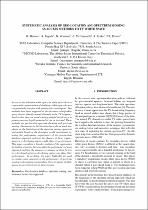 ResearchSpace
ResearchSpace
Systematic analysis of geo-location and spectrum sensing as access methods to TV white space
JavaScript is disabled for your browser. Some features of this site may not work without it.
- ResearchSpace
- →
- Research Publications/Outputs
- →
- Conference Publications
- →
- View Item
| dc.contributor.author |
Mauwa, H

|
|
| dc.contributor.author |
Bagula, A

|
|
| dc.contributor.author |
Zennaro, M

|
|
| dc.contributor.author |
Pietrosemoli, E

|
|
| dc.contributor.author |
Lysko, Albert A

|
|
| dc.contributor.author |
Brown, TX

|
|
| dc.date.accessioned | 2017-05-17T07:14:50Z | |
| dc.date.available | 2017-05-17T07:14:50Z | |
| dc.date.issued | 2016-11 | |
| dc.identifier.citation | Mauwa, H. et al. 2016. Systematic analysis of geo-location and spectrum sensing as access methods to TV white space. ICTs for a Sustainable World” ITU Kaleidoscope Conference, 14-16 November 2016, Bangkok, Thailand, p. 209-216 | en_US |
| dc.identifier.isbn | 978-92-61-20431-0 | |
| dc.identifier.uri | http://www.itu.int/en/publications/Documents/tsb/2016-ITU-Kaleidoscope/mobile/index.html#p=226 | |
| dc.identifier.uri | http://hdl.handle.net/10204/9090 | |
| dc.description | ICTs for a Sustainable World” ITU Kaleidoscope Conference, 14-16 November 2016, Bangkok, Thailand. | en_US |
| dc.description.abstract | Access to the television white space by white space devices comes with a major technical challenge: white space devices can potentially interfere with existing television signals. Two methods have been suggested in the literature to help white space devices identify unused channels in the TV frequency band so that they can avoid causing harmful interference to primary services legally protected to run on the band. These methods are geo-location spectrum database and spectrum sensing. Discussions in the literature have placed much emphasis on the limitations of the spectrum sensing approach and mainly based on the developed world environment ignoring the performance requirements of the geo-location database approach and how the absence of these requirements in a developing region could affect its performance. This paper considers a broader analysis of the approaches by looking at factors that can affect the performance of each approach and how the presence or absence of these factors in a developed region or developing region can affect their performance. In so doing, the paper highlights the need to conduct more research on the performance of spectrum sensing in developing regions where there are plenty of white spaces to ascertain its use in these regions. | en_US |
| dc.language.iso | en | en_US |
| dc.publisher | International Telecommunication Union (ITU) | en_US |
| dc.relation.ispartofseries | Worklist;17630 | |
| dc.subject | Geo-location databases | en_US |
| dc.subject | Spectrum sensing | en_US |
| dc.subject | Television white spaces | en_US |
| dc.title | Systematic analysis of geo-location and spectrum sensing as access methods to TV white space | en_US |
| dc.type | Conference Presentation | en_US |
| dc.identifier.apacitation | Mauwa, H., Bagula, A., Zennaro, M., Pietrosemoli, E., Lysko, A. A., & Brown, T. (2016). Systematic analysis of geo-location and spectrum sensing as access methods to TV white space. International Telecommunication Union (ITU). http://hdl.handle.net/10204/9090 | en_ZA |
| dc.identifier.chicagocitation | Mauwa, H, A Bagula, M Zennaro, E Pietrosemoli, Albert A Lysko, and TX Brown. "Systematic analysis of geo-location and spectrum sensing as access methods to TV white space." (2016): http://hdl.handle.net/10204/9090 | en_ZA |
| dc.identifier.vancouvercitation | Mauwa H, Bagula A, Zennaro M, Pietrosemoli E, Lysko AA, Brown T, Systematic analysis of geo-location and spectrum sensing as access methods to TV white space; International Telecommunication Union (ITU); 2016. http://hdl.handle.net/10204/9090 . | en_ZA |
| dc.identifier.ris | TY - Conference Presentation AU - Mauwa, H AU - Bagula, A AU - Zennaro, M AU - Pietrosemoli, E AU - Lysko, Albert A AU - Brown, TX AB - Access to the television white space by white space devices comes with a major technical challenge: white space devices can potentially interfere with existing television signals. Two methods have been suggested in the literature to help white space devices identify unused channels in the TV frequency band so that they can avoid causing harmful interference to primary services legally protected to run on the band. These methods are geo-location spectrum database and spectrum sensing. Discussions in the literature have placed much emphasis on the limitations of the spectrum sensing approach and mainly based on the developed world environment ignoring the performance requirements of the geo-location database approach and how the absence of these requirements in a developing region could affect its performance. This paper considers a broader analysis of the approaches by looking at factors that can affect the performance of each approach and how the presence or absence of these factors in a developed region or developing region can affect their performance. In so doing, the paper highlights the need to conduct more research on the performance of spectrum sensing in developing regions where there are plenty of white spaces to ascertain its use in these regions. DA - 2016-11 DB - ResearchSpace DP - CSIR KW - Geo-location databases KW - Spectrum sensing KW - Television white spaces LK - https://researchspace.csir.co.za PY - 2016 SM - 978-92-61-20431-0 T1 - Systematic analysis of geo-location and spectrum sensing as access methods to TV white space TI - Systematic analysis of geo-location and spectrum sensing as access methods to TV white space UR - http://hdl.handle.net/10204/9090 ER - | en_ZA |





